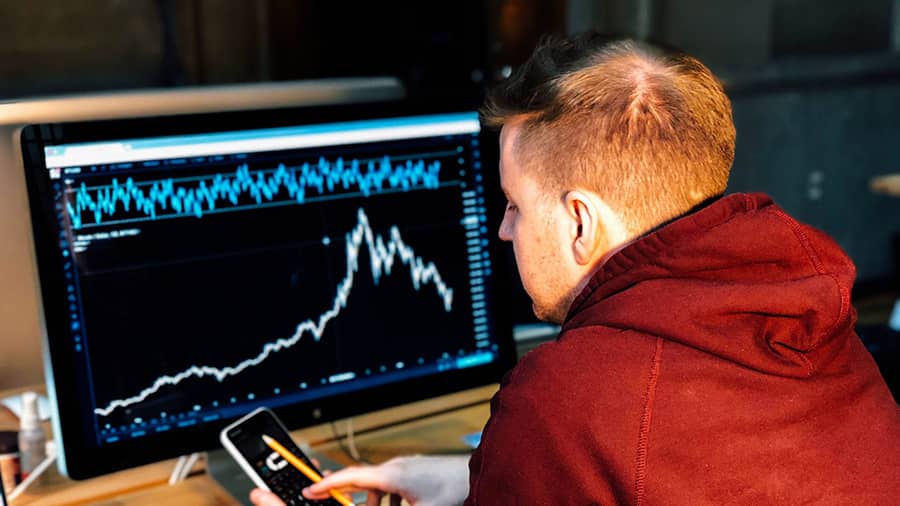Data Scientist Joris Peeters reveals the secrets behind our adaptive scorecards. How can we obtain reliable scores in economically unstable times? What is the outlook for the next 12 months and what can we learn from this crisis? Joris discusses these and more trending topics around business data.

Interview with Joris Peeters, Data Scientist at Altares Dun & Bradstreet.
At Altares Dun & Bradstreet, we are celebrating 10 years of adaptive scorecards this year. How does it work and what are the benefits for our users?
"Our industry (the collection and processing of business information) has been one of the biggest users of machine learning for many years. At Dun & Bradstreet, we already started developing the first scorecards in the United States in the mid-1980s. In the early 1990s, credit scoring was also developed for the Dutch Dun & Bradstreet database. In 1998, D&B conducted research with the Massachusetts Institute of Technology (MIT) on the use of AI (also known as Deep Learning) on the D&B databases. The conclusion of the research was that this technique provided some extra predictive power compared to the machine learning as used by D&B at the time, but we ran into the classic shortcoming of these techniques. That is the low level of explainability of how these systems arrive at a certain score, the famous 'black box'. Therefore, we continued to prefer scorecards that were easy to explain, even if they were (just) a little less predictive. To meet the high quality expectations of our customers (that our scorecards, and the scores, would dynamically adapt to a changing economic environment), we developed an adaptive system in 2011. With this, we had a transparent and explainable system, which was also able to adapt on its own."
Joris continues: "Without diving into the technology, the concept of the 'adaptive' scorecard is fairly simple: for a number of data fields in the scorecard, a company's data is continuously compared to the same data from other companies that are comparable in size and activities to that company. Because data is dynamic, the comparison base is also updated each time. For example, if the market shows strong growth, but your growth rate is lower than that of your peers, this could mean that your score is lower. Conversely, if you grow stronger than your peers, you can earn extra points. The 'market' acts as a benchmark and is updated regularly. We call this adapting to reality continuously. It ensures that the scorecard remains stable and that the data continues to improve."
"The main proof of quality is that the scores always keep pace with the changing economic situation. This has proven itself over the past few decades, where there was quite a lot of macroeconomic dynamic after all. The big advantage for our users is that there is no staircase effect. If a static result is adjusted with a new score, this might lead to an exaggerated shock; for example, a company suddenly jumps from rating 4 to 2. If a rating changes, there is always an explanation; such as a paydex or a filed balance sheet. Think of it as a fresh certificate for your data," says Joris Peeters.
In these economic times, is there anything accurate left to predict?
"These are extraordinary times" Joris acknowledges, "but the economic reality remains. We are always looking for correlations in order to get a grip on what is happening around us and what is about to happen. What we use to serve the market is to give the best possible answer to the question: 'What is the probability of bankruptcy in the next 12 months? The laws of late payment, a debt collection, the filing of a poor balance sheet are feeding our scores. Our models remain good because these signals persist. It is a reflection of the financial performance expressed as a probability. That's why we advise our clients: keep a close eye on the payment morale."
What makes our scores and ratings unique?
Joris Peeters: "So one of the secrets is the adaptive scorecard. It will always win over a traditional calculation. In addition, we have 20 years of historical data available on which we can continue to test and analyze. We can build very reliable indicators from the gigantic trade database of trade and payment transactions. Looking back at the predictions, since the implementation of the adaptive scorecard, every year we have consistently seen between 70% - 75% of all bankruptcies coming early enough."
What are the key changes made in order to keep serving the market?
"In 2011, we developed the adaptive scorecard system. Given the turbulent macro economic conditions after the 2008/2009 crisis, we tested this system thoroughly before launching it in 2013. The customer still has the same product while its quality has been continuously improved to meet the highest standard. Together with the customer, we have tested this quality again and again. This means that a user of our Rating and Scores can make decisions with confidence, time after time. The adaptive system also has the great advantage of giving us more time to support our customers in optimizing their credit policy. This can range from supporting our clients on how to use our scores and ratings in the best possible way, to supporting clients who have specific requirements. For the latter we can then use our knowledge and expertise to work out customized scoring solutions.
This has given us the opportunity to deepen our knowledge and to develop new scoring techniques. We are now on the threshold of a whole new scoring methodology, which we are going to bring to the market in a broader sense this year. The first results are promising: every test we did showed that we could increase turnover at a lower risk: accepting more customers for a lower risk. As a bonus, this system can not only indicate who has a high probability of bankruptcy, but also when this is likely to happen."
What is your outlook and expectation of the next 12 months ahead of us?
"Once governments will cut back on subsidies we will see an increase in risk. Specifically, this means that companies will pay slower and bankruptcies will increase. The true impact on the economy can only be observed when the subsidies stop. I do not expect a major downward spiral or horror scenario. The resilience of our region and also of the countries around us is great. Yes, there is an impact, but... just let the old go bankrupt and the new rise. Good things emerge from harsh times, leaving us in a better place as as a society. I think of it as a purge within the entrepreneurial landscape. If Thomas Cook had not fallen over in 2019, it would still have happened now," Joris stated.
"Take the construction sector, it's cyclical, it goes with the flow of fluctuations. Most of the more permanent gaps are in the sectors with low barriers to entry, such as hospitality. Obviously, with a production plant, you have a completely different story. In time, I expect to see more homegrown production to ensure higher continuity and control of the supply chain."
In terms of financial health, what can we learn from this crisis?
"Good business management! A rainy day fund! It seems like an open door, but as you can see, you are strongest when you have money behind you. There are a number of examples of companies that have recently gone bankrupt that did not have this covered. Companies that have managed on the razor's edge have taken the worst hits.
Some business models have been disrupted forever, look at the use of Microsoft Teams and delivery services like Take Away. The use of these services is only accelerated by Corona. At this point, if you haven't gone along with it, it's not going to happen. At the end of the day, I believe we're really going to benefit from this."
Our Data Scientist's advice:
• Doing business in a sane way;
• Reinvent your business model, put your customer first;
• Be creative;
• Be mindful. Keep an eye on the risks.
Altares Dun & Bradstreet: your data partner
Altares Dun & Bradstreet helps organizations create a corporate culture that prioritizes data as a strategic weapon. Our Dun & Bradstreet data cloudis an inexhaustible source of information, with insights that 90% of all fortune 500 companies access daily. Do you need help setting up a master data management strategy? Get in touch with us.
